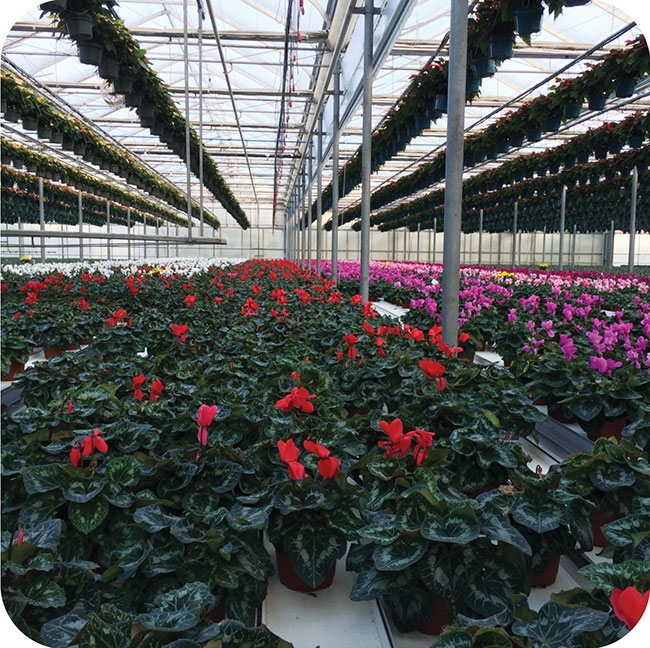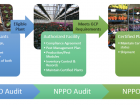
News
Export: New program, new rules
Key details on the new certification program for exporting greenhouse-grown plants
January 19, 2019 By Dr. Jeanine West and Andrew Morse

When most people think of ornamental plants they imagine beautiful and fragrant ways to decorate a space, celebrate a holiday, or brighten up someone’s day. Very few consumers think of the challenges associated with growing and moving flowers and plants between the growing facility and the retailer. Ornamental plant growers across North America take significant efforts to ensure that these plants for planting do not pose a biosecurity threat.
The requirements for moving plants across borders are carefully crafted to effectively mitigate the risk of pest spread, either known or unknown (new) pests.
The United States-Canada Greenhouse Grown Plant Certification Program (GCP) is a bilateral trade program that is available as of December 2018 (replacing the Canadian Greenhouse Certification Program and D-96-12) and allows facilities to export eligible product without obtaining an official inspection at the time of shipping. This is a critical advantage in a global marketplace where ‘just in time’ business models are commonplace.
The GCP is based on a systems approach, but an evolved version over previous trade programs. The principles of the systems approach in managing phytosanitary risk have resulted in very successful improvements in mitigating pest spread within North America. The GCP has evolved to have a more demonstrative approach, focusing on pest management over the course of plant production as opposed to the documentation surrounding individual certification activities. The new GCP was developed cooperatively by CFIA and APHIS; details can be found in the technical requirements document dated June 2016 (available here: http://www.inspection.gc.ca/plants/horticulture/exports/gcp-technical-requirements/eng/1474666508713/1474666604536). The document describing how the program will be administered in Canada is the CFIA directive D-16-02, also available online.
What’s new?
There are a number of new opportunities within the GCP that may be particularly valuable to your business, for example:
- What is particularly useful for many facilities is that the GCP includes the opportunity for shipping potted plants that have had a period of outdoor production. This represents a significant shift for CFIA and USDA-APHIS, and opens the door to quick turnaround exports for a wider range of plants.
- An additional opportunity is possible for facilities that ship plants with bamboo stakes or ornamental greenery (i.e. “Associated Articles”) that would normally require a Phytosanitary Certificate. If a facility is authorized as a GCP facility, then they can ship these plants under the GCP without a separate Phytosanitary Certificate for the Associated Article.
For both of these options, a facility will be required to have a “Production Module”, defined as:
“Additional pest risk management measures employed to permit an exemption from a requirement of the GCP and/or to address concerns regarding specific production conditions included in the Pest Management Plan.” ~CFIA
“Pest Modules” are similar to Production Modules, but address regulated pests as opposed to production conditions. Not always required, they are another new tool describing actions taken by the facility to prevent pest spread.
How will the changes affect my facility?
There are some more detailed requirements on the facility side in the new program. The facility will be taking on more responsibility with the GCP, for example:
- The development of a List of Plants in Production, where all the plants that may be grown at the facility must be categorized for eligibility to be shipped under the program, not just plants intended for export.
- Plants grown for less than a 28-day crop cycle (called the ‘Growth and Monitoring Period’) may require additional measures to ensure that phytosanitary risks have been mitigated. In the legacy program, there was no defined growing cycle.
- The GCP incorporates a “whole facility” approach, meaning the entire facility is managed regularly for pests; the result is a facility where designated personnel are more likely to detect and manage new/introduced pests more effectively.
- While the “Excluded Plant List” required under the legacy program is no longer required, it is now the facility’s responsibility to verify eligibility under the GCP of all incoming plants for production, and ensure that the requirements of both USA and Canada are met.
Can non-exporting facilities participate in the GCP?
Yes! Due to the high incidence of internal trade in the floriculture sector, production facilities (that sell domestically) wishing to sell eligible product to exporting facilities are encouraged to participate in the GCP. The GCP structure encourages ‘intentional and ongoing’ pest management for a whole facility, which means better quality finished product that carries lowered phytosanitary risk. GCP-Authorized Facilities will be thrilled to receive plants that are certified under the GCP, helping to streamline their exporting process.
Where can facilities get support for the GCP?
In preparation for the transition to the GCP, Flowers Canada Growers initiated the development of a nation-wide training platform back in 2016 to support both plant producer and broker facilities in their transition. Developed in collaboration with the CFIA, the nation-wide training platform guides the facility through the principles of the GCP (systems approach, mitigation of risk, plant eligibility) and the administrative processes. Templates for Pest Modules are included in the training, as well as detailed examples of how to complete a Pest Management Plan and the most common Production Modules. By completing this training, facilities will promote increased skill development within the floriculture sector in this critical area, and ensure consistent application and interpretation of the GCP at the industry level.
The platform is provided in two formats: in-person workshops and online (login access available through GCP@fco.ca). The online system allows FCG to reach out to all facilities to provide timely notification of changes to the GCP or relevant import/export information, and has the ability to track acknowledgement of the receipt of these updates.
The immense benefit associated with close industry-government cooperation on the development and rollout of the GCP cannot be ignored. By creating a strong and unified national understanding of program requirements within the industry, facilities are better prepared to manage their obligations in this trade program, reducing the risks to Canada and the United States, and manage resource burdens on the CFIA.
GCP Industry Training is available through a collaboration between Flowers Canada Growers Inc., the Fédération Interdisciplinaire de l’Horticulture Ornementale du Québec (FIHOQ), and l’Institut Québécois du Développement de l’Horticulture Ornementale (IQDHO). Contact GCP@fco.ca for more information; support is available in both English and French. Support is also available from your local CFIA office.
Jeanine West, PhD, is the greenhouse certification program project lead, and Andrew Morse is the executive director at Flowers Canada Growers Inc. They can be reached at jeanine@fco.ca or andrew@fco.ca.
Print this page

